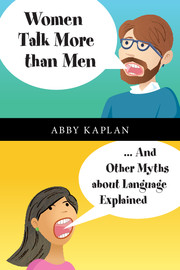Book contents
- Frontmatter
- Contents
- List of figures
- List of tables
- Acknowledgments
- 1 Introduction
- Part I … But is it language?
- 2 ‘A dialect is a collection of mistakes’
- 3 ‘Sign language is skilled charades’
- 4 ‘Chimpanzees can talk to us’
- Part II Language learning
- Part III Language in use
- Appendix A Statistics brief reference
- Language index
- People index
- General index
4 - ‘Chimpanzees can talk to us’
from Part I - … But is it language?
Published online by Cambridge University Press: 05 April 2016
- Frontmatter
- Contents
- List of figures
- List of tables
- Acknowledgments
- 1 Introduction
- Part I … But is it language?
- 2 ‘A dialect is a collection of mistakes’
- 3 ‘Sign language is skilled charades’
- 4 ‘Chimpanzees can talk to us’
- Part II Language learning
- Part III Language in use
- Appendix A Statistics brief reference
- Language index
- People index
- General index
Summary
If a rabbit defined intelligence the way man does, then the most intelligent animal would be a rabbit, followed by the animal most willing to obey the commands of a rabbit.
Robert Brault, A Robert Brault Reader, rbrault.blogspot.com
If you want to get a sense of what the apes may have experienced in some of the studies described below, do exercise (1) under ‘For further reflection’ before reading this chapter.
People use language with animals all the time.We talk to dogs, cats, horses, dolphins, parrots – any animal we have the opportunity to interact with. Much of this speech is used for commands, of course: we tell dogs to sit or fetch and instruct horses on when to go or stop. But our use of language with animals isn't restricted to giving orders; it's common, for example, for people to talk to their pets they way they would talk to another human.
And animals respond. Dogs, horses, and other animals can be trained to obey commands given in human language. Parrots repeat words and phrases they hear humans using around them. Many pet owners swear that their pets understand English. People have to be careful about using words like walk or vet around their dogs because they know what kind of reaction they'll get.
In this chapter, the crucial question that we will ask is whether this behavior really involves language in a meaningful way. When a dog responds to the command to sit, does that dog understand the meaning of the word in a linguistic sense? Or has it simply learned ‘when I hear those sounds, if I sit, I'll get a reward’? When the dog's owner talks about her bad day and the dog comes over to comfort her, is the dog a language user or just an expert at reading the owner's body language?
Dogs and dolphins don't talk back, of course. Human voices sound the way they do because of the particular shape of the human mouth and throat; we can't expect a dog to make human sounds, just as humans can't exactly recreate a dog's bark. Even great apes, who are more anatomically similar to humans, don't have the physiological equipment necessary for human speech.
- Type
- Chapter
- Information
- Women Talk More Than Men... And Other Myths about Language Explained, pp. 52 - 76Publisher: Cambridge University PressPrint publication year: 2016



